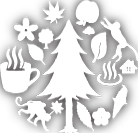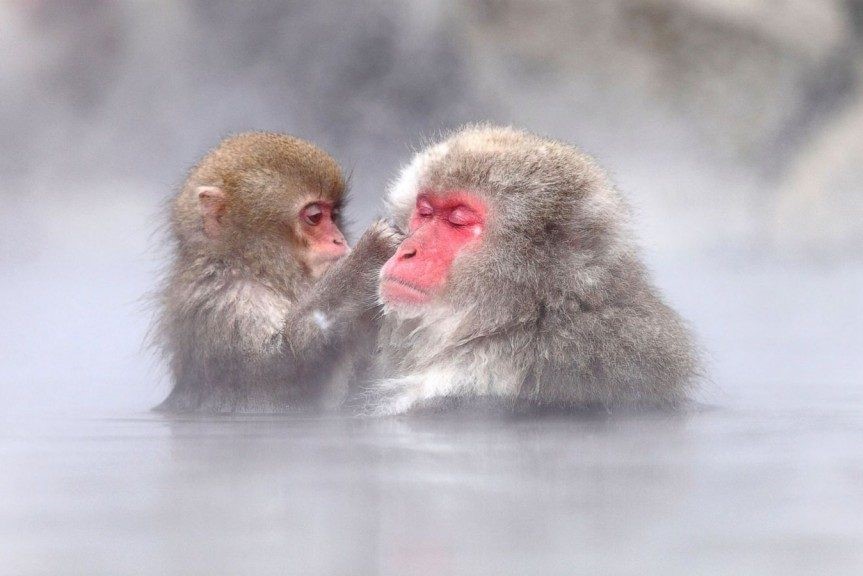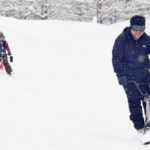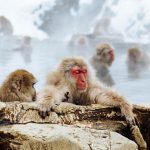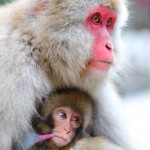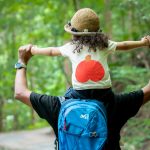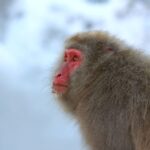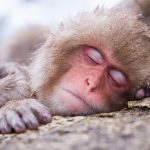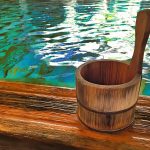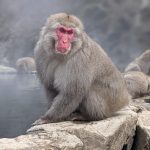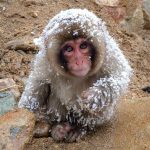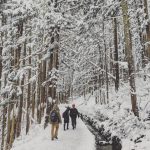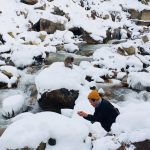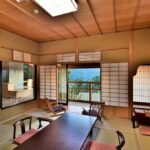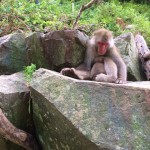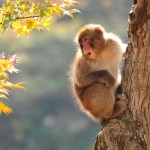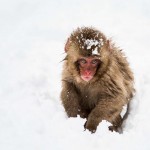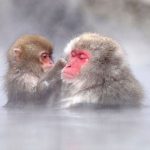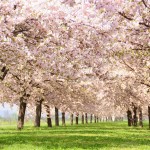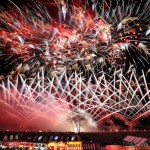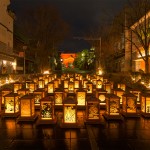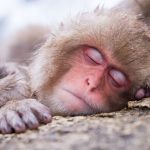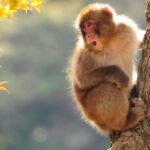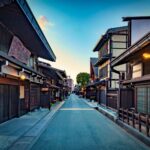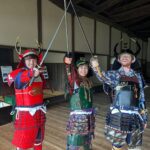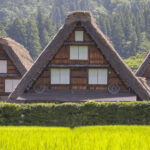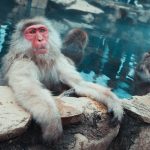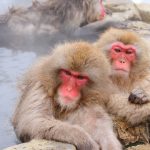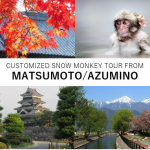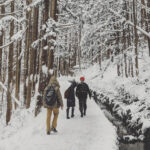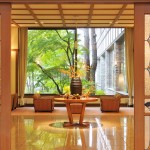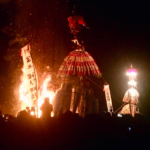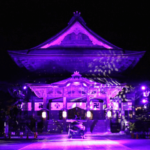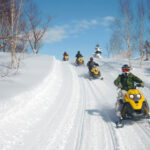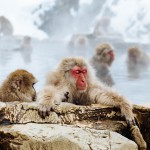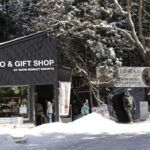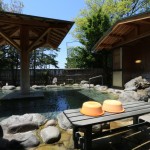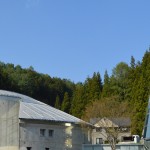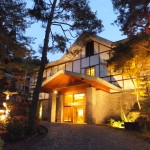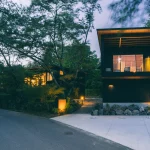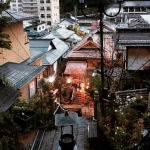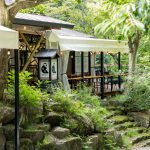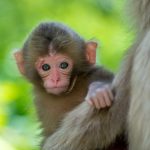Spring (March-May) at the Jigokudani Monkey Park
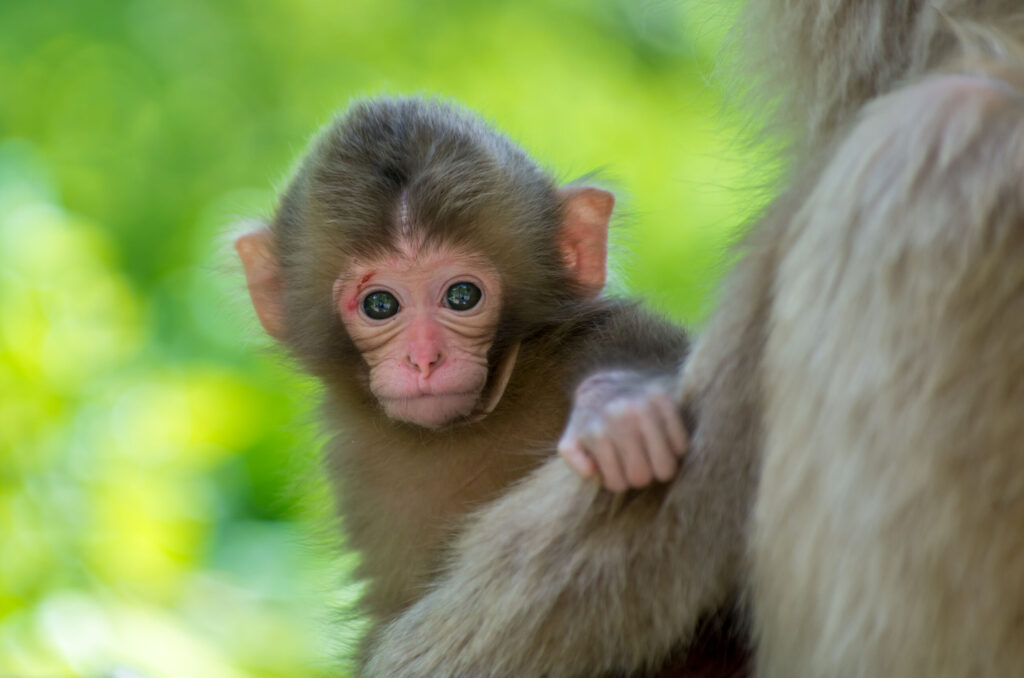
As the weather warm-up in April, and Nagano escapes its long, cold winter, spring offers lots of reasons to visit the Jigokudani Monkey Park. It is a time of renewal and new beginnings as the region’s cherry blossoms bloom in April and the park welcomes the newborn babies for the season. On this page you will find the following information:
— Snow Monkey Park Operating Hours in Spring
— Baby Monkeys at the Snow Monkey Park
— March in the Snow Monkey Park
— April in the Snow Monkey Park
— Spring Tours at the Monkey Park and More!
— 25 Things to Do Around the Park & Where to Stay
Nagano’s spring comes a little later than many regions of Japan, as the snow slowly starts to melt from late-March into April. As it does, some of Nagano’s most iconic destinations including Kamikochi, the Tateyama-Kurobe Alpine Route, and the Nakasendo Trail become accessible again making it an ideal season to visit the park in combination with these and other destinations.
For information regarding opening times, entry tickets and access please refer to our ‘Snow Monkey Park Information’ page, while our ‘The Snow Monkey FAQs’ page answers the most common questions when planning a visit.
SNOW MONKEY PARK OPERATING HOURS IN SPRING
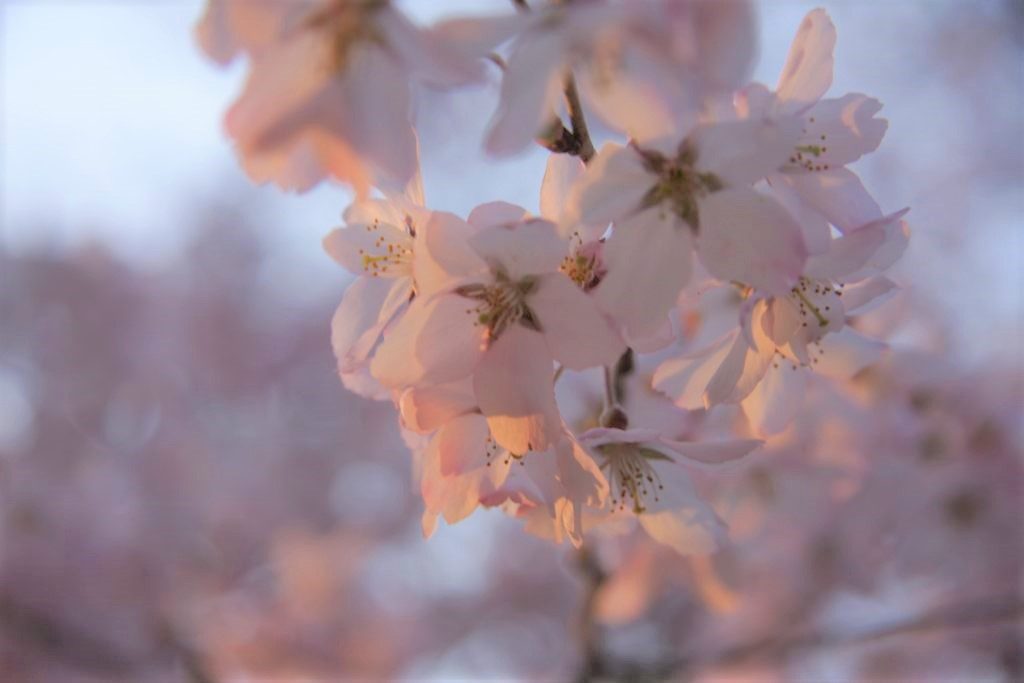
The Jigokudani Monkey Park operating hours are not the same year round, so it is very important to make sure that you double check the hours before visiting. The operations are split into two main periods, the green season of April – October, and the winter season of November – March. As Spring is composed of the months of March through May, you can see that the season is actually is split between the two periods. The green season operations are 08:30 – 17:00, while the winter season is 09:00 – 16:00. Because of this, if you visit in March you will need to abide by the winter season rules, while if you are making your trip in April or May you will have the longer green season hours. Please note that the park hours are subject to change on any given due to extreme inclement weather or other events which interfere with park operation. Additionally, the date of switchover between the two operation periods may not always coincide exactly with the first day of the month.
WHAT TO EXPECT IN SPRING
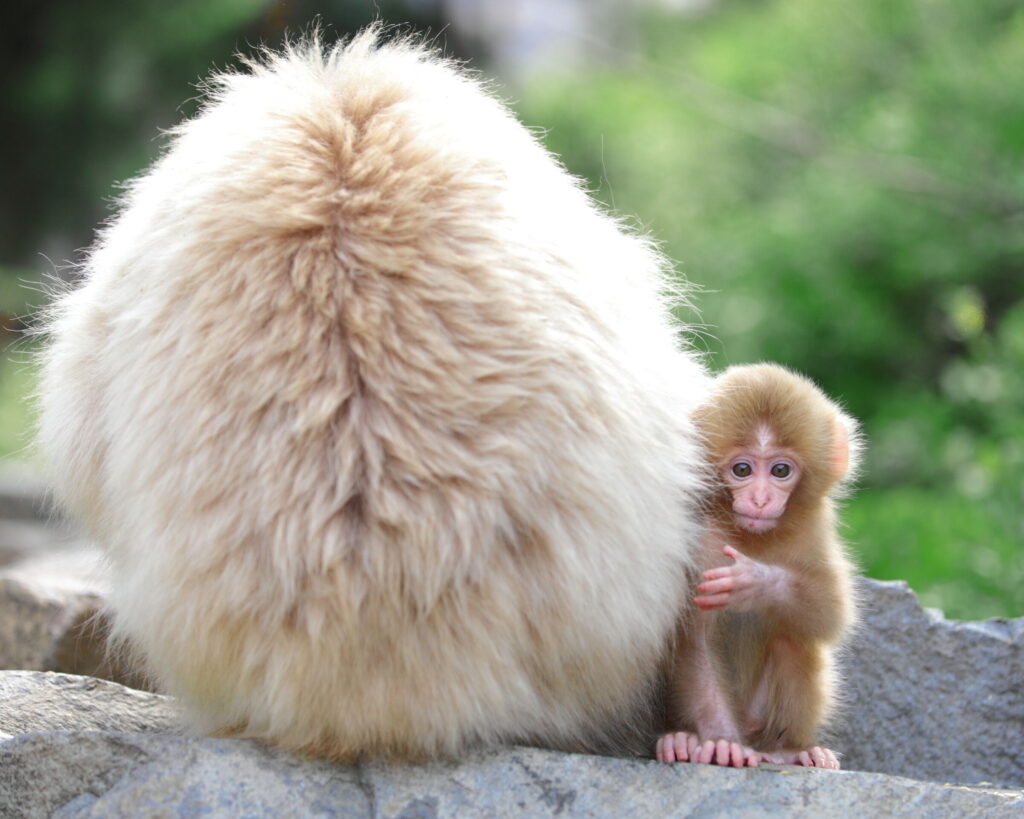
April to May is a fantastic time to visit the park. With the snow mostly gone, warm days encourage new growth in the park, which gradually turns lush green through may. Warmer temperatures also mean that the monkeys are more active, scurrying about the park and forest seemingly happy that the cold of winter has now gone.
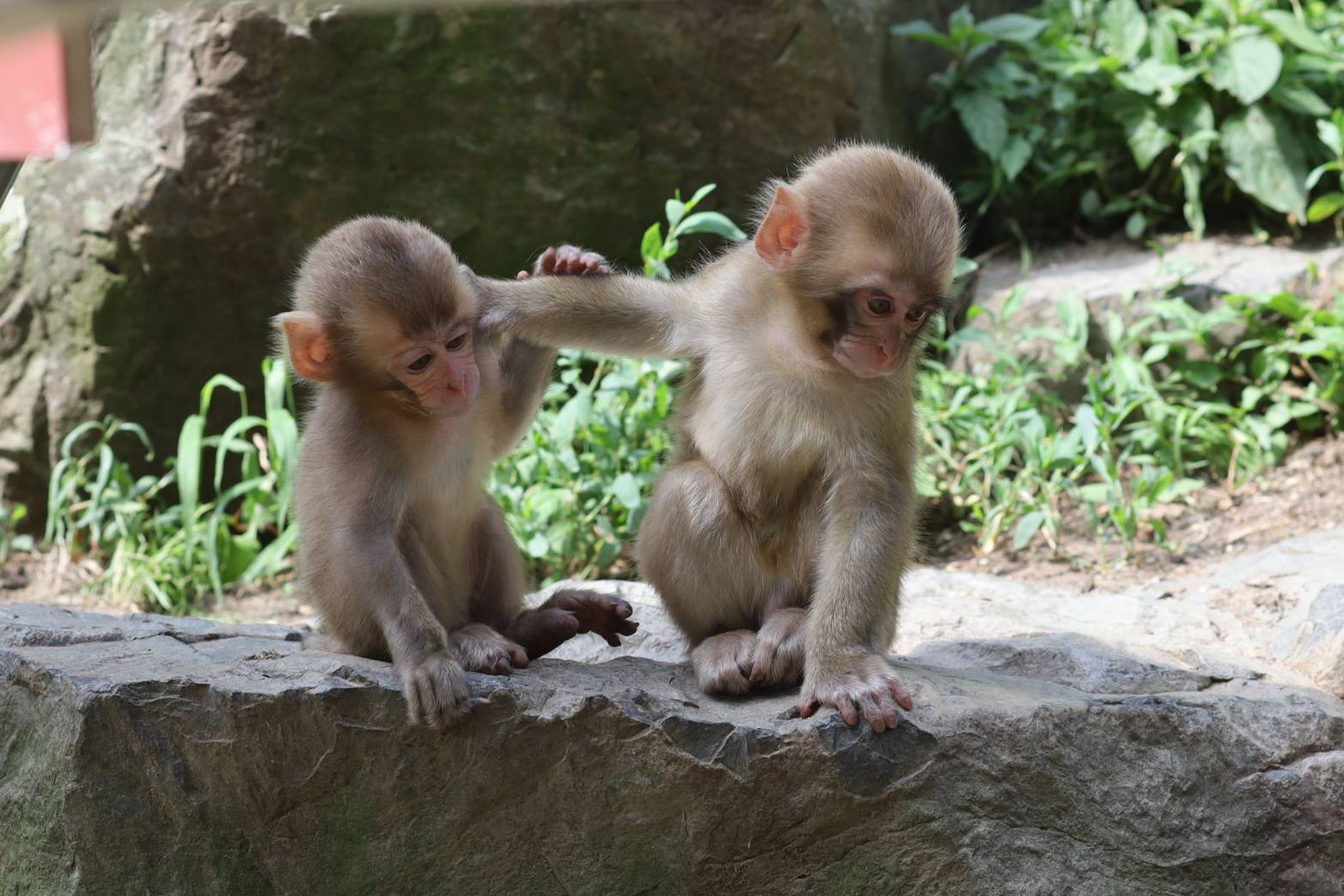
The monkeys behavior is reliable however from late-April onward, expectant mothers will give birth. Prior to doing so, they retreat into the mountains where they give birth away from prying eyes. Once comfortable again, the mums will return with their babies, often after around a weeklong absence. This means that total monkey numbers can sometimes be less in spring but it isn’t something to worry about. There should still be plenty of them in the park. The weather should be warm and the trail and park will be free of snow and ice, Nevertheless, good quality footwear is recommended and it is always worth it to be prepared for the walk to the park with merchandise and English-language information available at the Snow Monkey Resorts Gift & Info Shop.
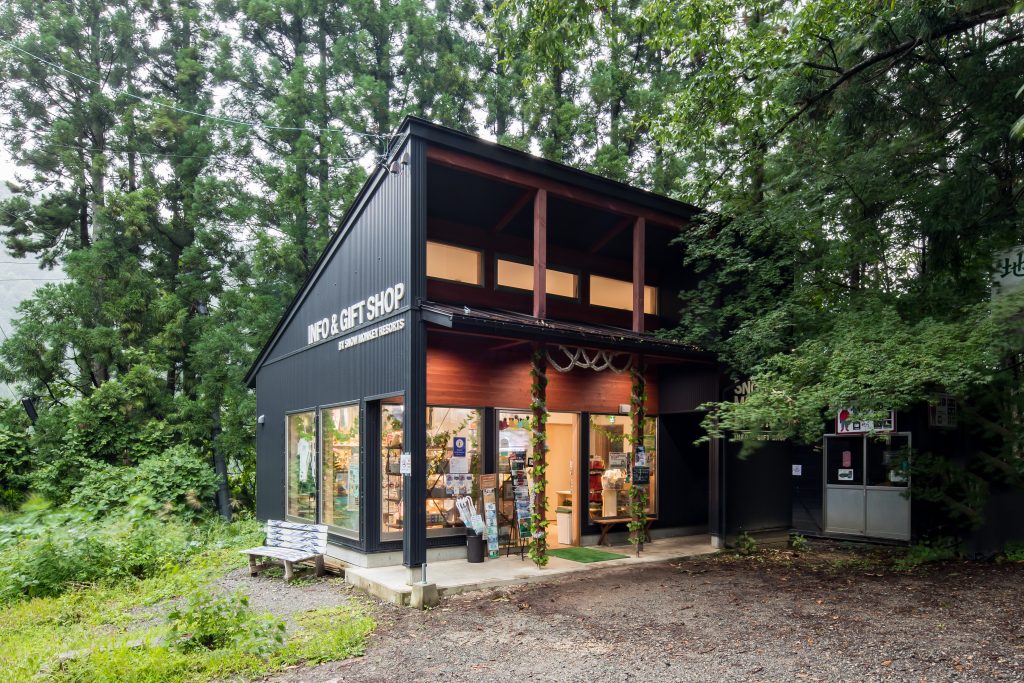
Just down from the trail entrance and the Info & Gift Shop, Enza Cafe is open throughout the year including in spring. It serves a tasty menu of Japanese and Western favourite and offers both indoor and outdoor seating in which you can comfortably sit back, relax and take your time at the park.
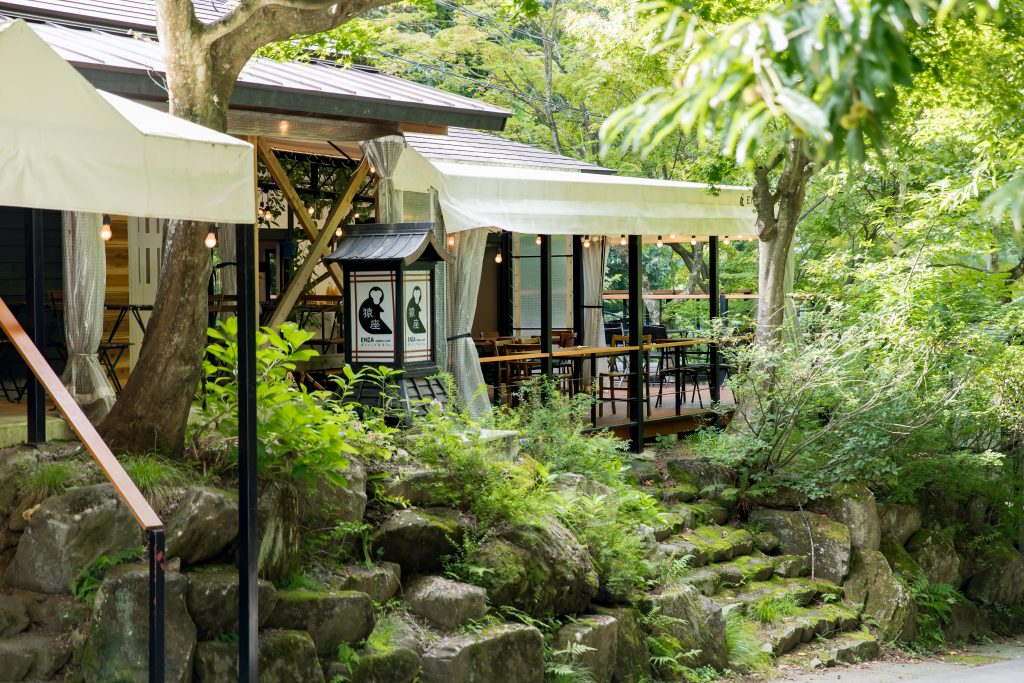
Operating by reservation and located only a little further down the trail (near the Nagaden Express Bus Stop), Hotarutei is another recommended lunch option nearby the monkey park and offers classy Japanese Cuisine in a 170 year old, carefully renovated farmhouse.
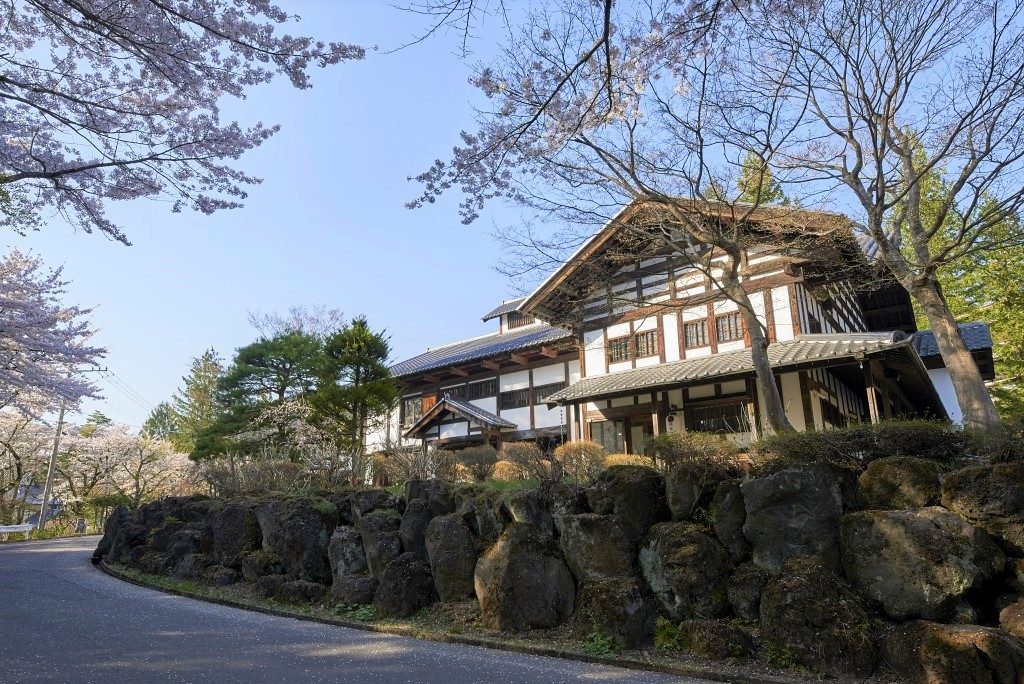
The weather will typically go up and down through spring. However one thing is certain – peak season at the park is over and visitor numbers will be much lower. Daytime temperatures are likely to between 10°C and 20°C but be prepared that it can suddenly dip, with the possibility of around 5°C. For information regarding other seasons in the monkey park, please refer our ‘Snow Monkey Park Throughout the Year’ page.
BABY MONKEYS AT THE SNOW MONKEY PARK
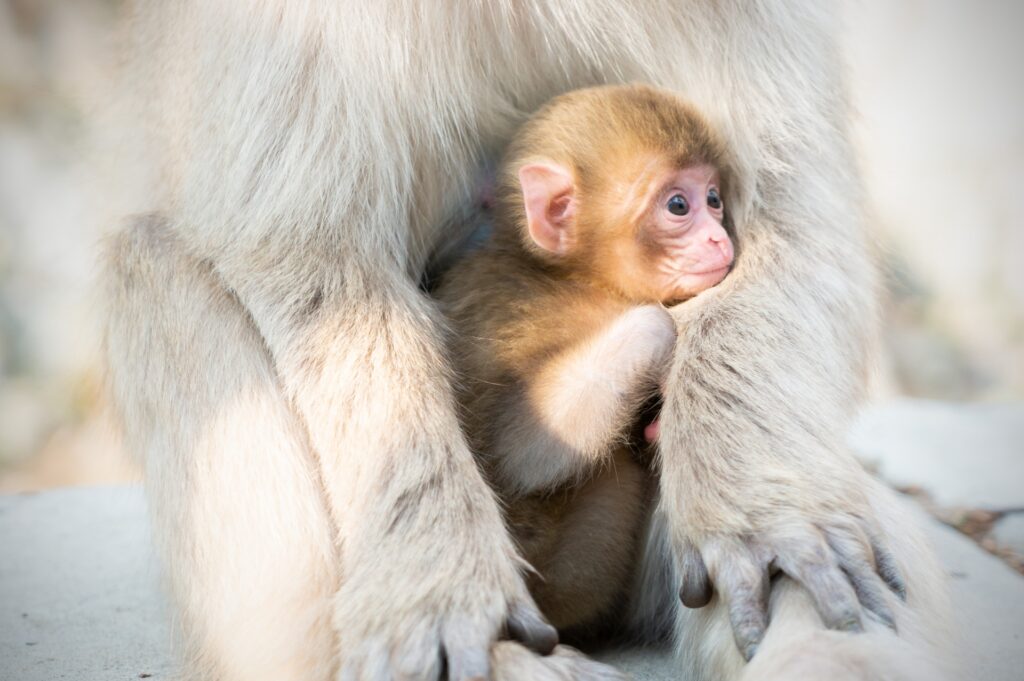
As mentioned briefly above, Spring is the season of baby monkeys. While the snows of winter may be on their way out, especially from April onwards, the park is blessed with the birth of new monkeys as another great reason to visit. Absolutely tiny at first, early in the season the babies will never leave their mothers side and can be seen hanging on to her fur, either under her stomach or on her back. A little later in the season, however, you will see them begin to venture a little further from mom and play with their companions born in the same year, or perhaps some of the older monkeys from the year before.

Unlike the adults, the babies do not yet have a bright red face and butt. For monkeys, the red skin on the extremities comes as a sign of their maturity and readiness to breed, and perhaps indicates overall health. For this reason, the babies will still have a few years to go until they too can boast a bright red face while relaxing in the onsen. They are in now rush to grow up however – the new babies in spring will still be wide eyed with wonder and ready to explore the world, under the watchful eyes of their attentive mother.
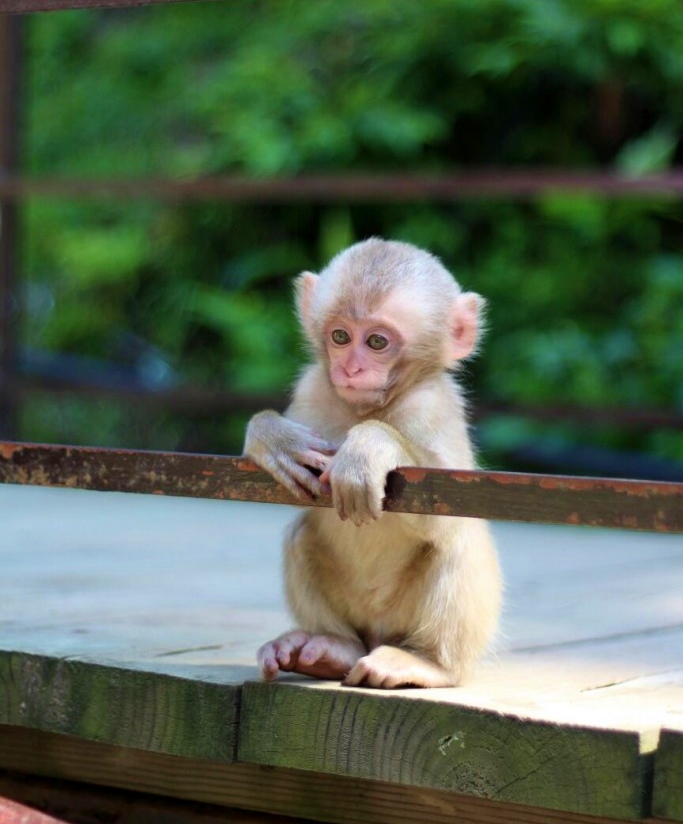


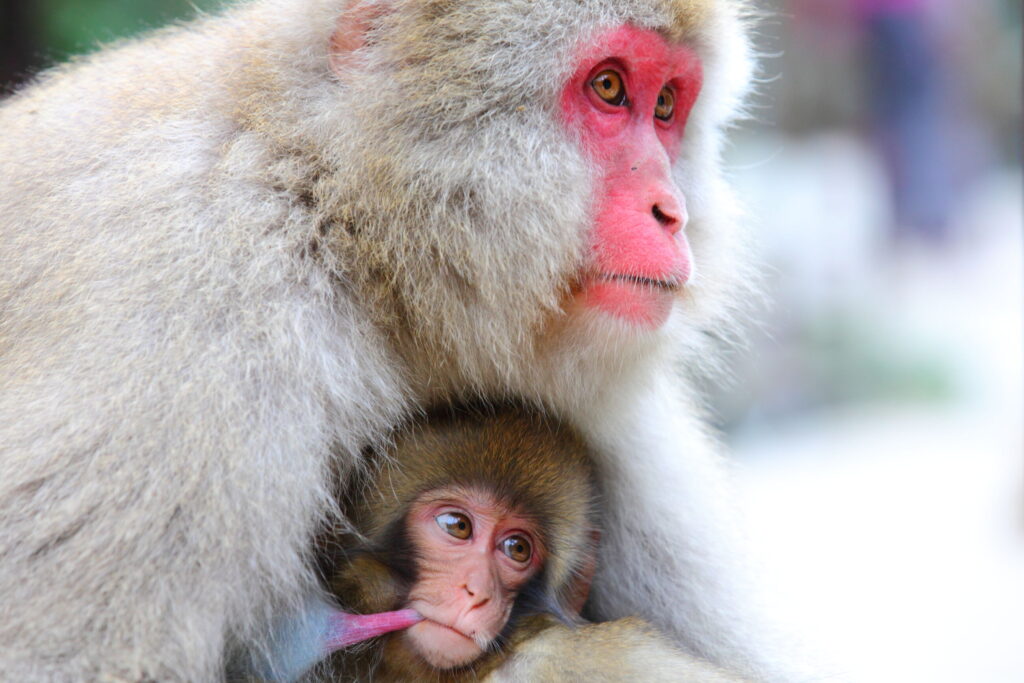
For the visitors who make it to the park in Spring, all of the cuteness and joy the baby monkeys bring is awaiting you. And with less visitors than peak season, it will be much easier to spend as much time as you want at the park to enjoy the antics of these little furballs.
MARCH IN THE SNOW MONKEY PARK
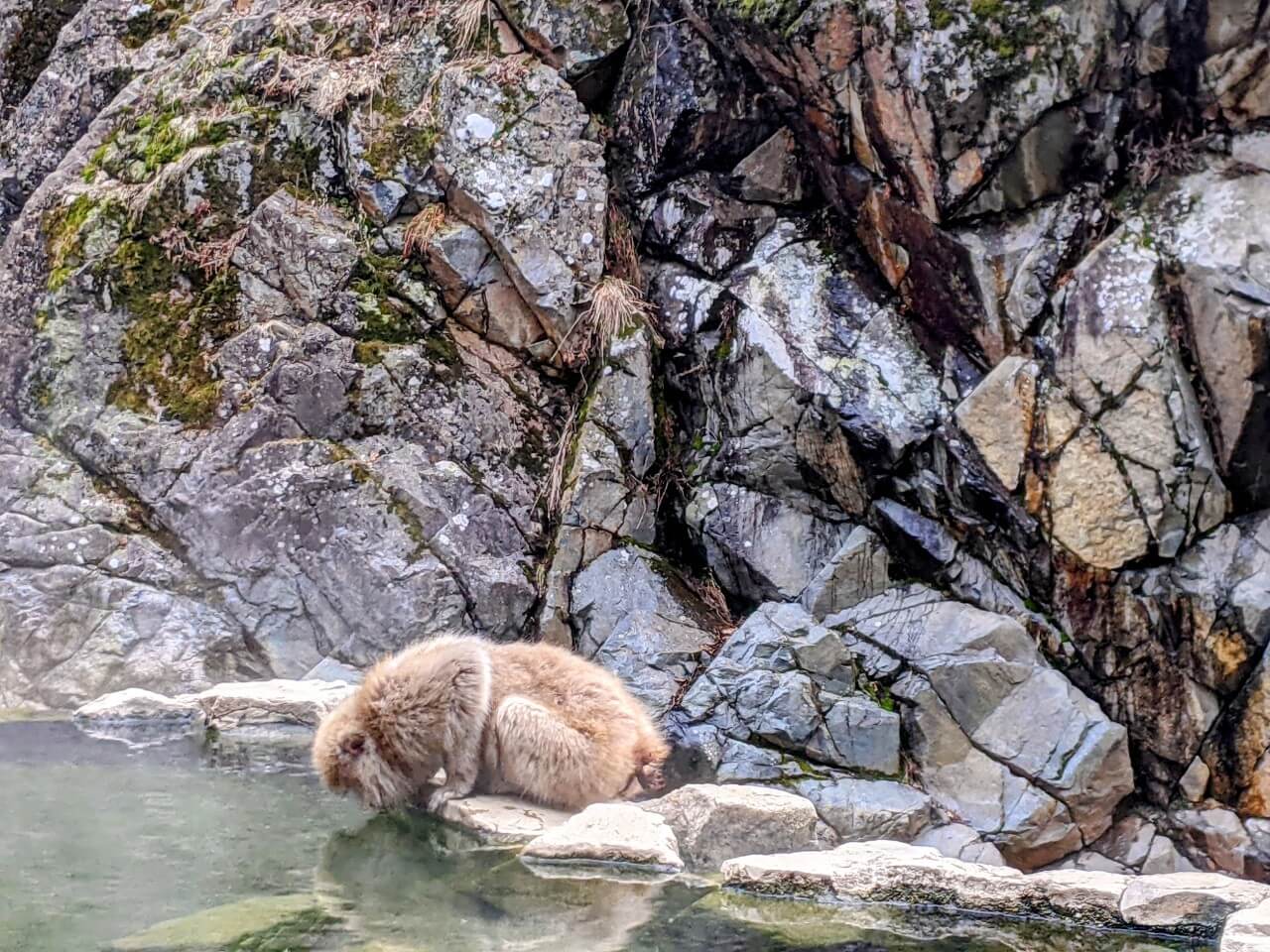
March in the Snow Monkey Park may technically be spring, but it’s still a lot like winter with frequent snow and freezing temperatures. Towards the end of the month, there may be a few warmer days but a jacket will still be a good item to bring with you. For the monkeys, march means that fresh edible plants will soon be growing and the season for birthing babies is getting closer. Many pregnant monkeys will frequently visit the hot spring during the later part of their pregnancy, perhaps to ease the associated body aches and pains.
For human visitors to the park, understand that while the daytime highs may reach over 15 degrees on warmer days, they will often be lower, below 10 degrees or even below 5 degrees. Nights will still be below freezing and very cold as well, so it is important to wear layers and not forget about the cold. Rain is a possibility as well as heavy snow, so checking the weather forecast and preparing an umbrella will help you avoid your trip being cold and wet.
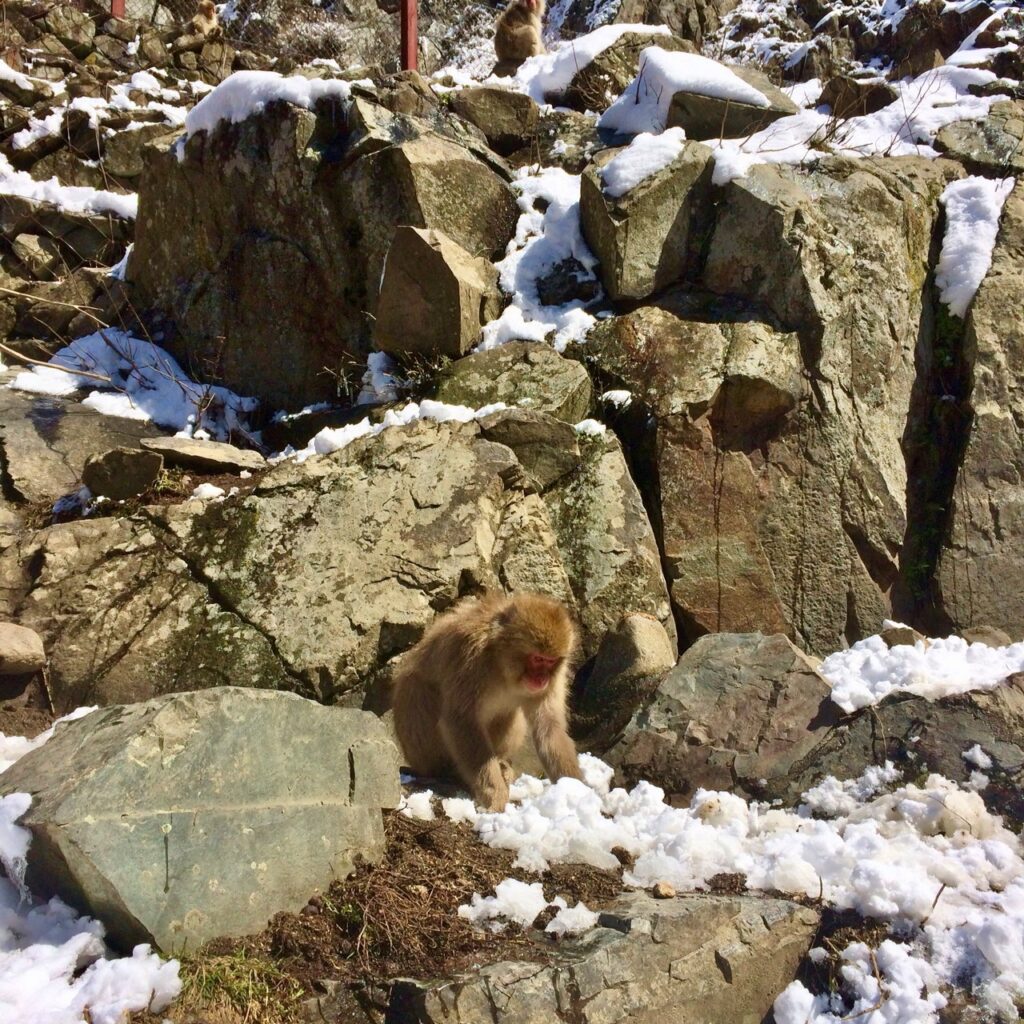
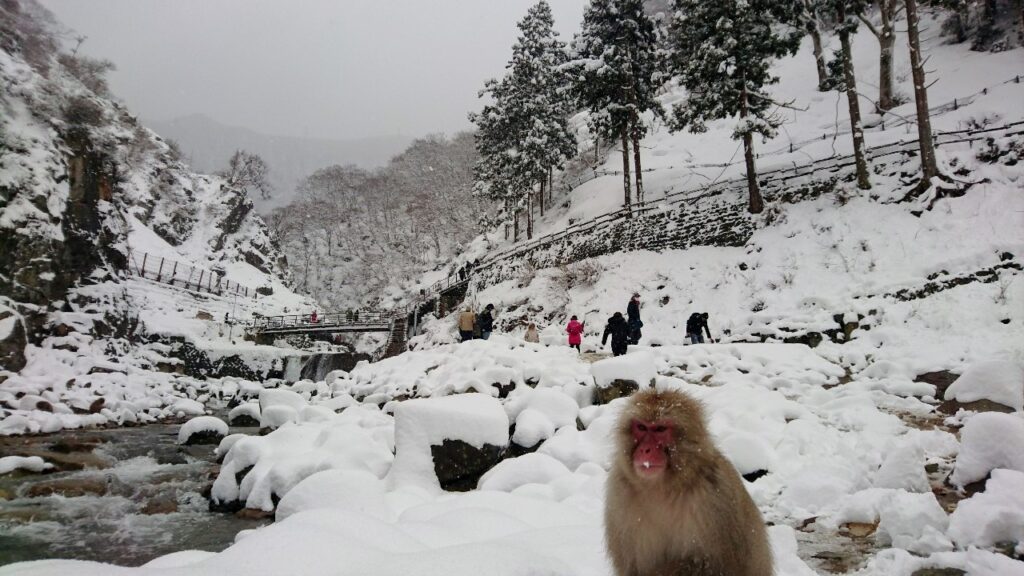
As you can see in the above photos taken by our staff at the park, March really can mean a lot of snow, but will still have smaller crowds than the peak season in January and February. This means it may just be the best time of year to come if you want to see the monkeys in the snow with nobody blocking your view – an unfortunately common problem during the peak season.
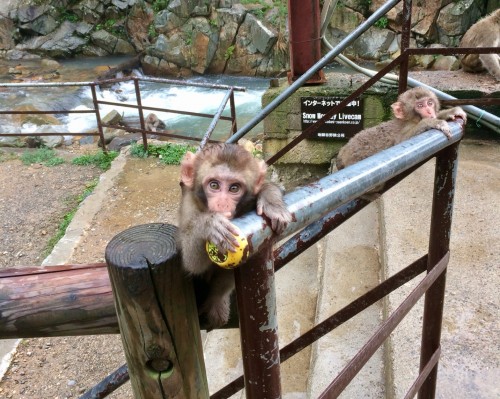
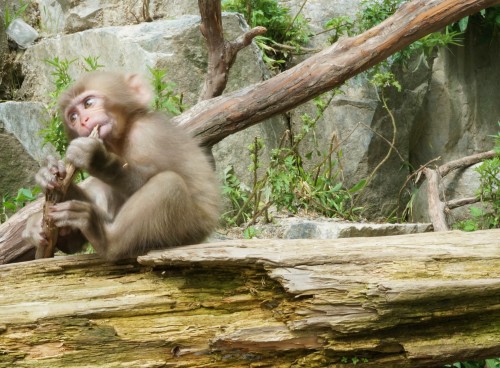
While the new years batch of babies won’t be born just yet, the kids from the previous spring will still be plenty small and cute. Just like human toddlers, they can be found chewing and climbing on just about everything. Unlike humans, however, they have the acrobatic skills necessary to not fall (most of the time), giving their moms a respite to focus on finding food or relaxing in the hot springs.
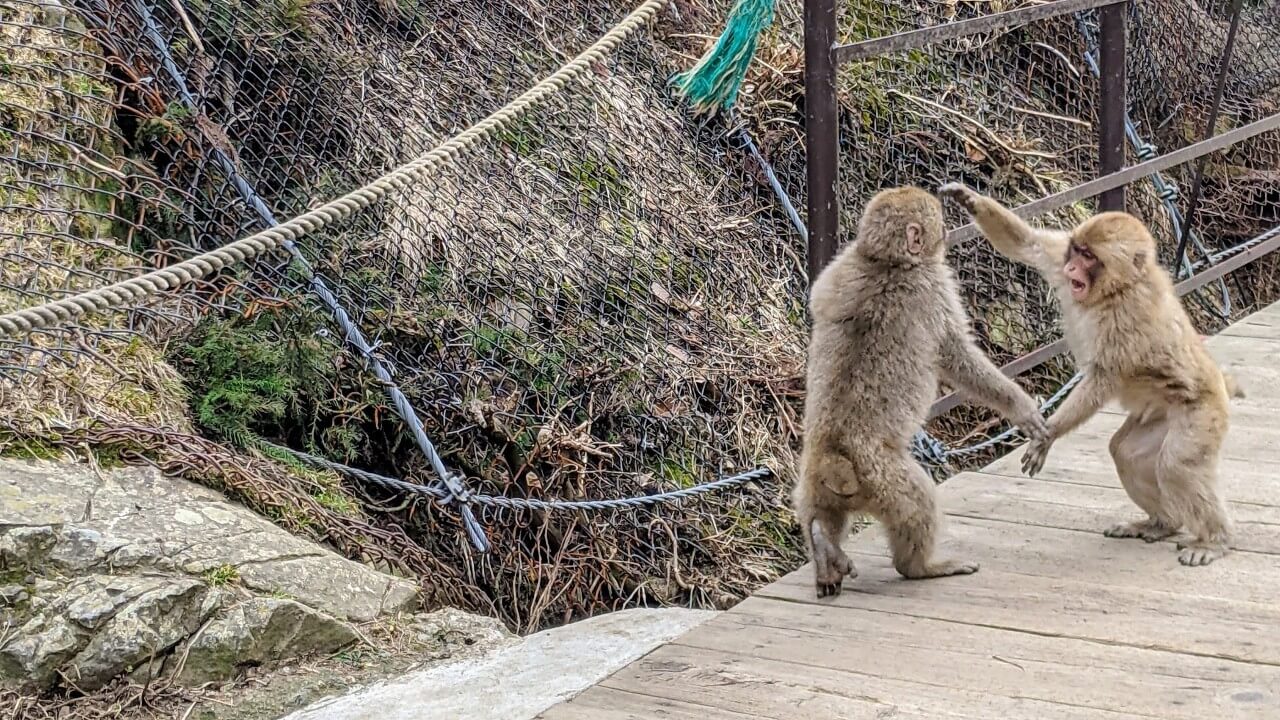
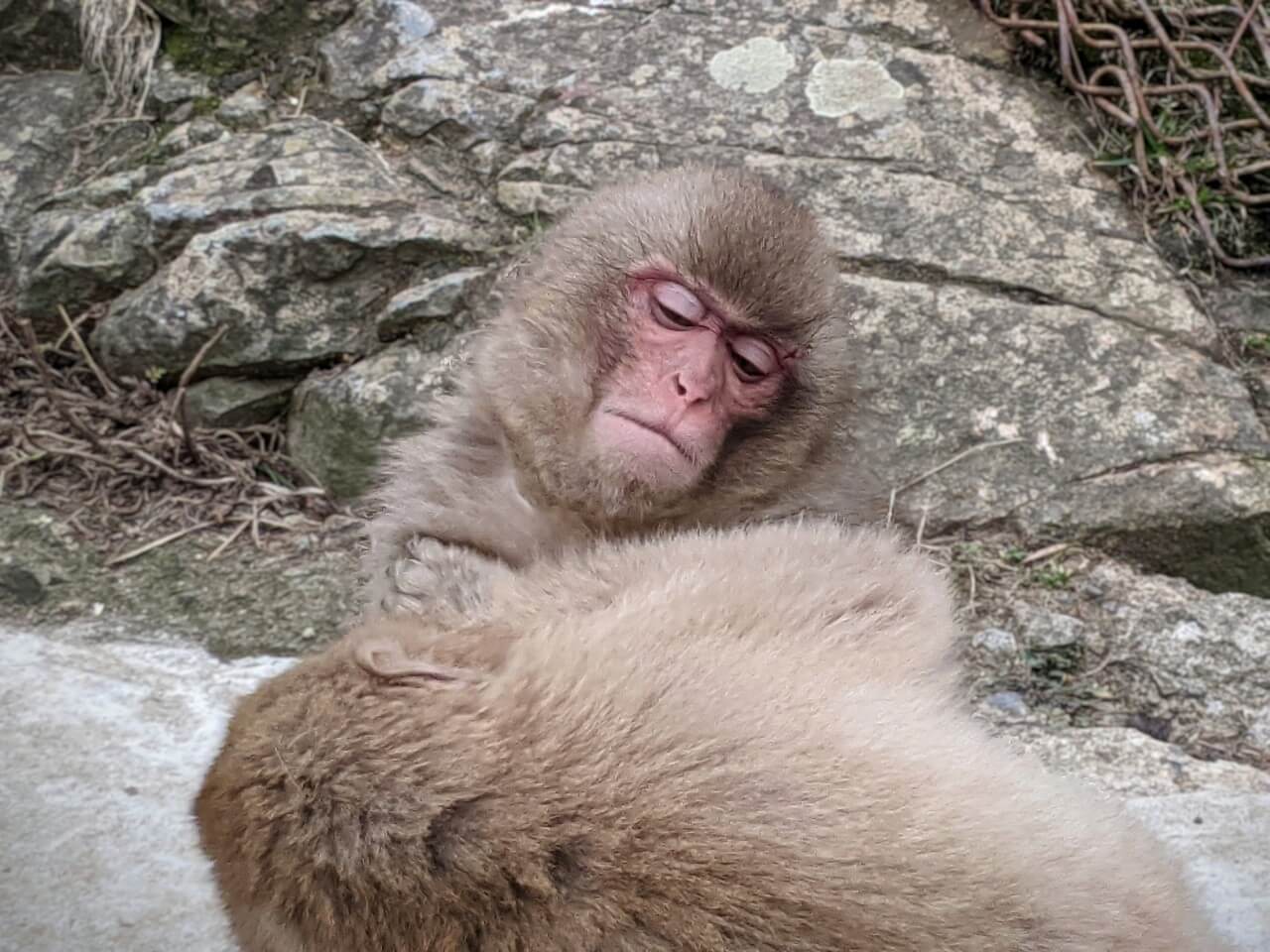
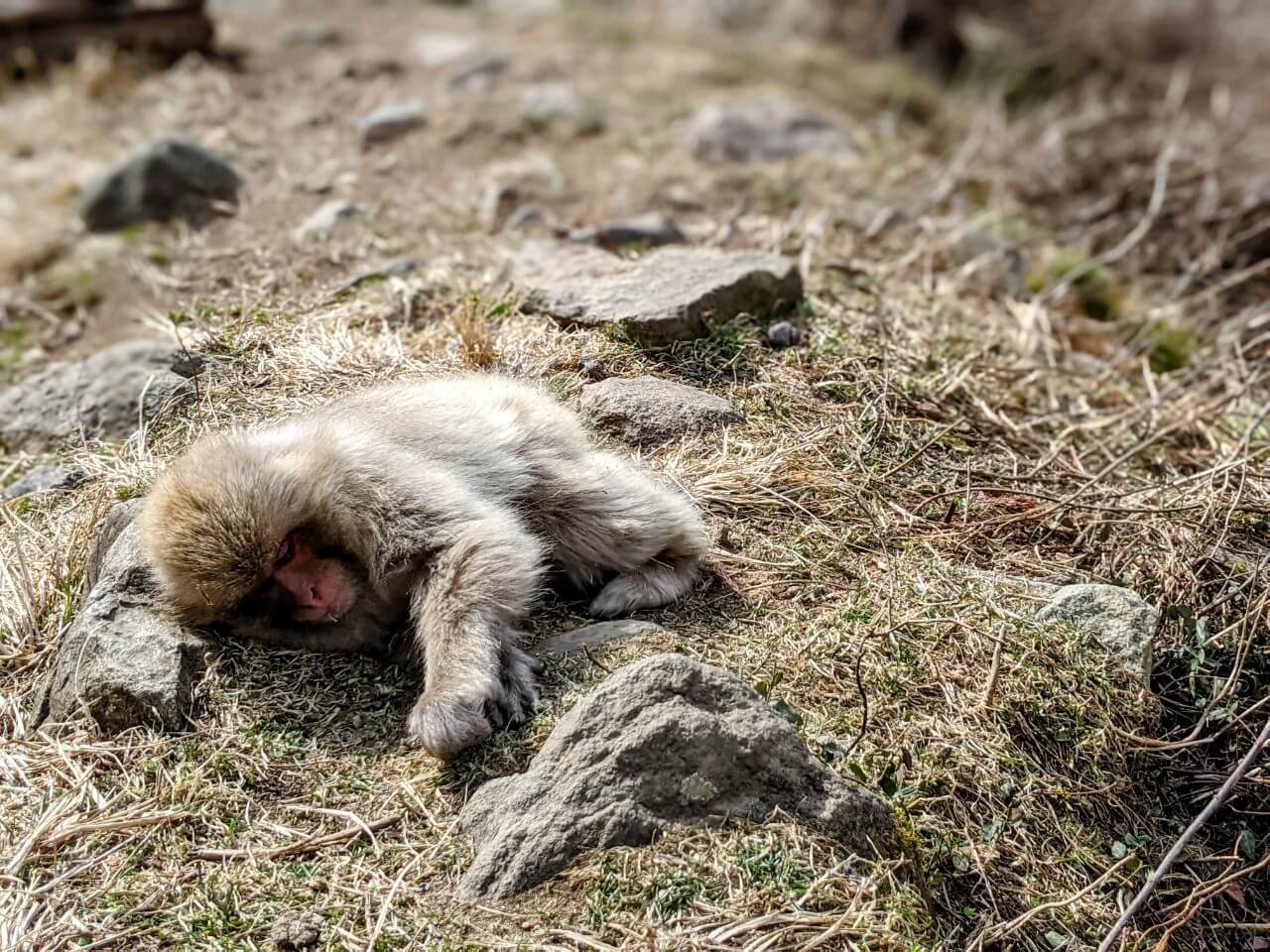
Meanwhile, the other monkeys will be found enjoying the sun in areas where the snow has melted, or perhaps grooming or play wrestling with each other. Since March can feel like both spring and winter depending on the day, you never know what behavior the monkeys will be up to but it will be entertaining regardless. And, with the cold air still hanging around, there will be at least a few in the bath for most of the month.
APRIL IN THE SNOW MONKEY PARK

While March can still feel quite wintery, April heralds the undisputed start of spring and the return of some greenery to the monkey park. With new babies being born everyday and lots of action from happy monkeys who have spent all winter toughing out the weather, April offers a lot to see with less crowds.
Expect daytime highs of over 20 on the warmest days, but also colder days close to 10-15 especially early in the month. Nighttime will still be bringing cold temperatures, but usually still above freezing and so a heavy jacket will not be necessary. Rain is not uncommon in April as well, and it always pays to check the weather forecast and bring an umbrella if the skies are even a little grey.
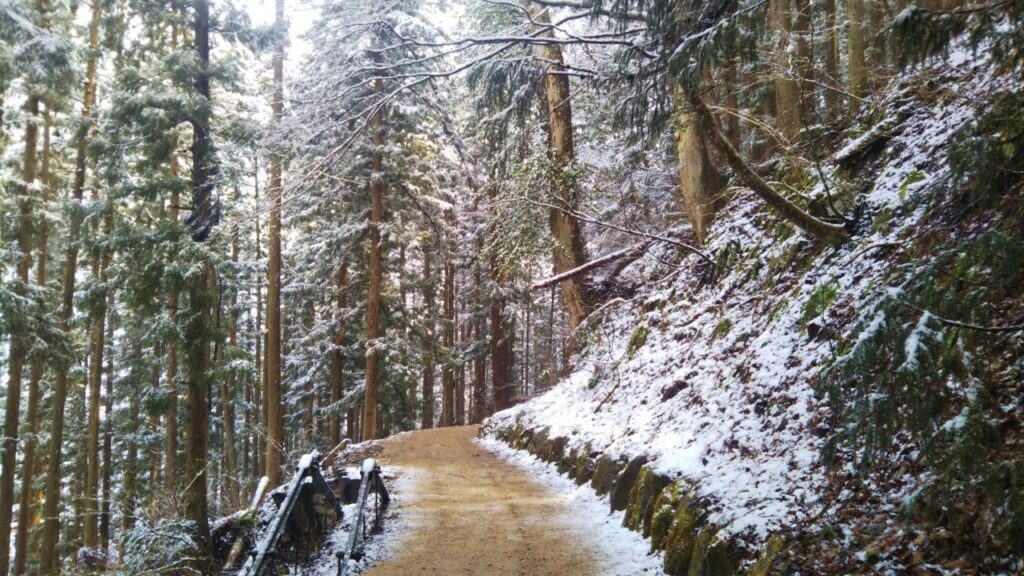
Of course, a little spring snow is also not unheard of in the mountains of Nagano and you may enjoy a light dusting especially early in the month. This shouldn’t be much of a hinderance to your visit however, and instead makes for a lovely addition to the landscape of newly emerging greenery.
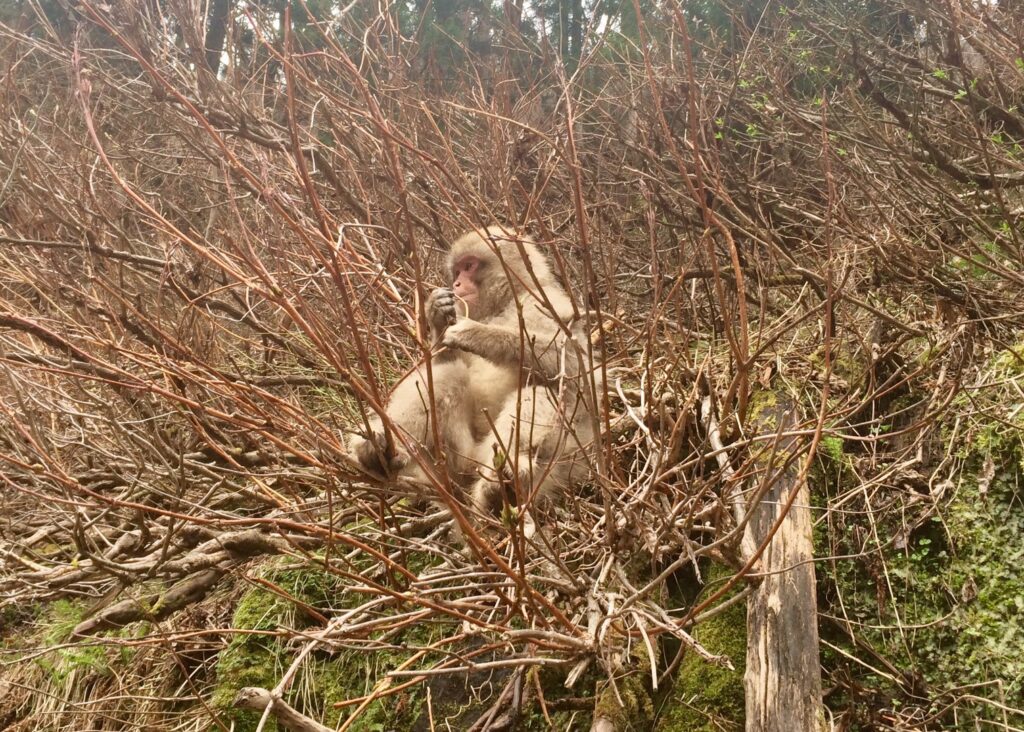
The trees will still be bare for a large part of April, making it easy to spot the monkeys frolicking amongst the branches and searching for edible new shoots. If you keep an eye open, you will be able to see monkeys all around far up the surrounding mountains, as they rarely all congregate around the hot spring at the same time. Their coat colors do a good job of blending in, so you will need a sharp eye!




Otherwise, monkey life will continue as normal with new babies being born, older babies still clinging to their mothers, and of course lots of hot spring bathing. While rainy days may not be ideal for a stroll, the cold weather will actually cause more monkeys to enter the bath and so it is not necessarily the case that rain will ruin your experience. On a sunny day, expect to see more of the play wrestling, grooming, and food collecting that make the monkeys endlessly enjoyable to watch.
MAY IN THE SNOW MONKEY PARK
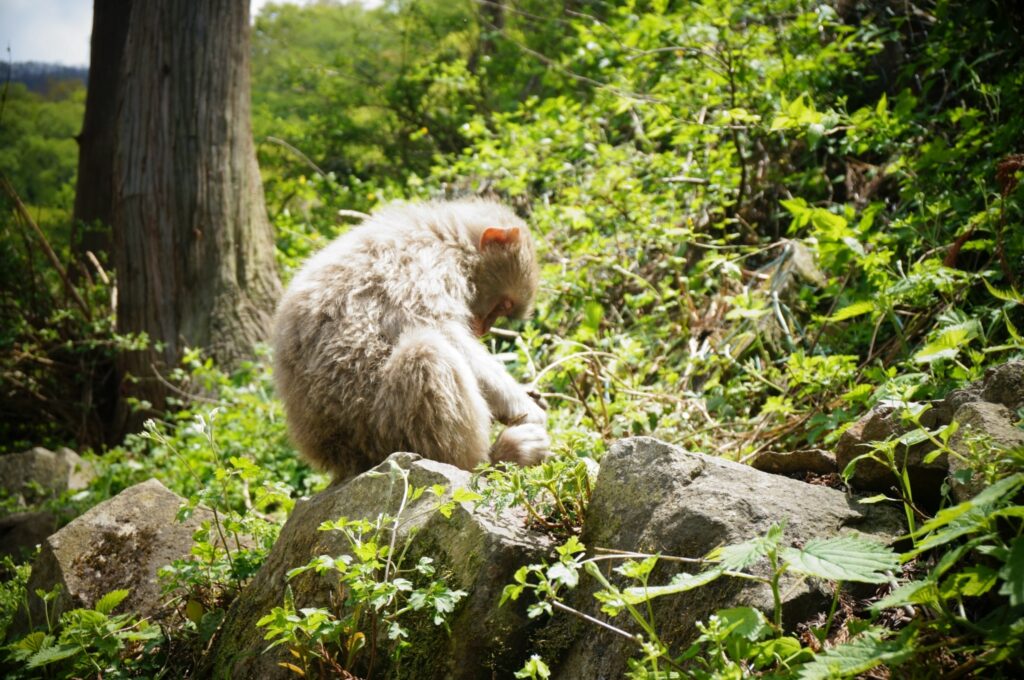
In May, the greenery will have finally triumphed over winter and returned to its full glory, with bright green fresh leaves enveloping the valleys around the Monkey Park. For the monkeys, this is a great time of year, as it is for the human visitor as well. Warm weather and a lot of sun make for a great environment to take your time and relax watching the monkeys complete their daily tasks.
Expect highs of up to 25 or more at the park, and nigh times hovering around 12 – 15 degrees. On most days, a long sleeve shirt or hoodie will be more than enough, and in mid day short sleeve shirts are also suitable for most travelers, especially when sunny out. By this time, all the snow will be melted and with no chance of new snow falling, you can begin to feel summer around the corner.
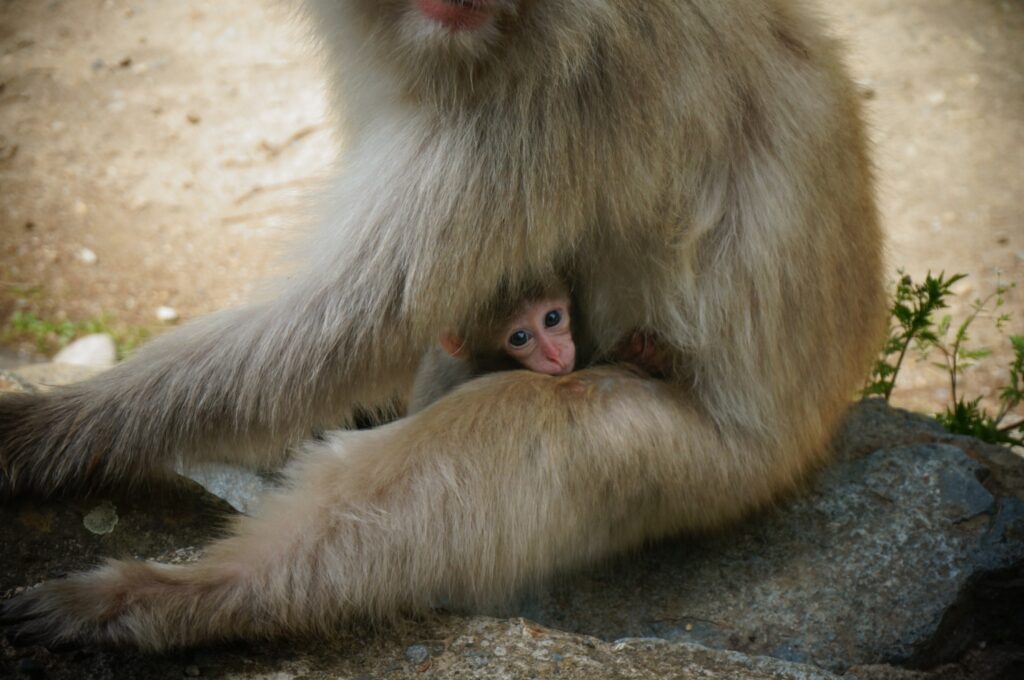
The best part of May is the newborn babies, who will now be out in full force. Truly tiny, you might at first confuse the 1 year old monkeys running around the park for newborns – but once you see a real newborn, clinging to its moms stomach fur, you will know the difference!
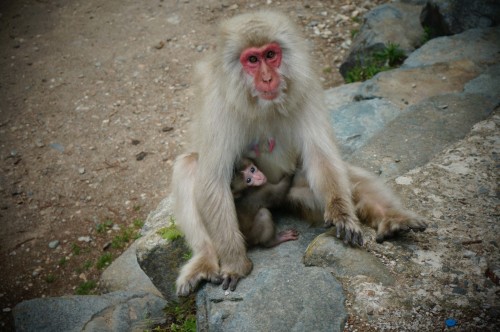
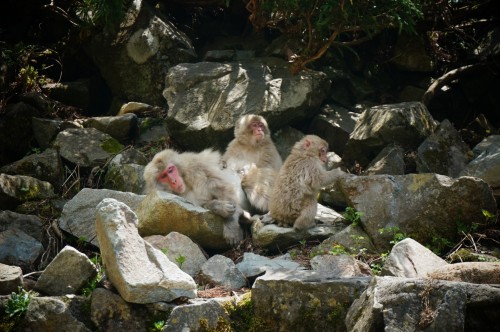
For now, the babies won’t be far from mom, and the mothers will go about their lives relatively normally. The babies know to hold on to mom and are rather well behaved, at least at this stage in their life. The gangs of teenager and young adult monkeys roaming around are a different story, and they will be making the most of the sun to start pushing their luck in the social hierarchy and try bossing around elders.
SPRING TOURS AT THE MONKEY PARK AND MORE!

If reading this page has convinced you to visit the Monkey Park in spring, our tours are here to provide you all of the monkey business Japan has to offer. And while the monkeys may be one of Nagano’s biggest attractions, they are from from the only thing this lovely prefecture has to offer. Keep reading below for the details on all of our best spring tours around Nagano, all with convenient pick up from Nagano Station and other major destinations such as Matsumoto City.
1 Day Tour

| 1-Day Tour: Snow Monkeys, Zenkoji Temple & Sake in Nagano | |
|
| |
| Period | All Year Round |
| Time | 09:35 – 17:35 |
| Meeting Place | Nagano Station Hakuba (winter only) |
| Adult Rate | ¥17,800 |
| Child Rate | ¥11,000 |

Operating year round and offering a full day itinerary including sake tasting, lunch, a visit to the historic Zenkoji Temple and of course a guided tour of the Snow Monkey Park, this day tour is the best option for anyone looking to explore Nagano with ease. Instead of worrying about catching trains or buses, you can instead ride on our tour bus with a guide who will make sure to handle all of the difficult parts for you.
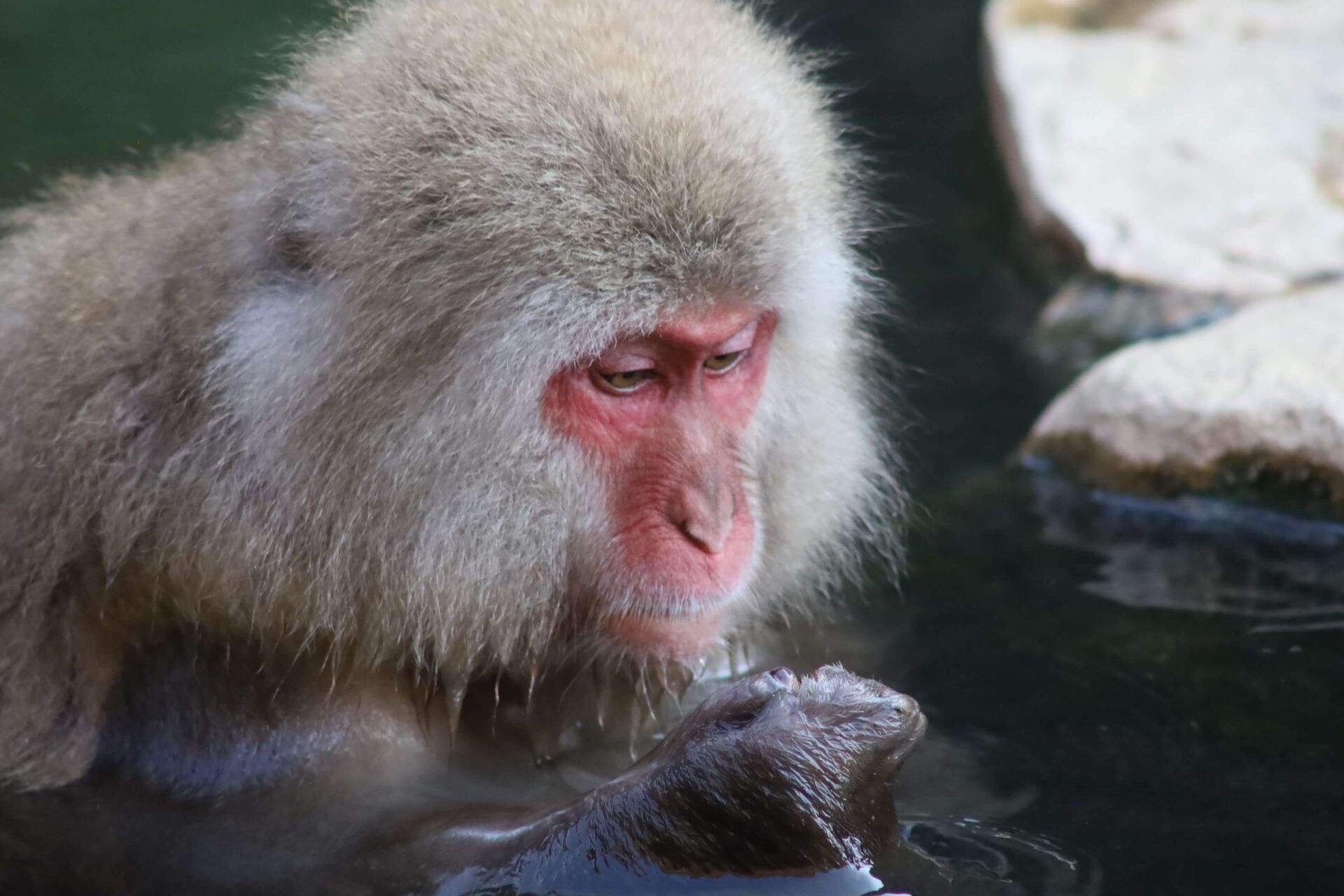
Possible as a day trip from Tokyo, those looking to see a different side of Japan will definitely enjoy themselves. In Spring, when the number of guests at the park has dropped off and the monkeys are at their most playful, you will have a chance to enjoy the antics at your own pace while asking any questions you think of to your helpful guide.
Private Tour
| [START FROM NAGANO CITY] Private Snow Monkey Tour | |
|
| |
| Period | All Year Round |
| Time | 09:00 to 17:15 ~ 18:30 |
| Meeting Place | Any location in Nagano City |
| Price | ¥122,000 ~ / group |

For guests searching for a more personalized experience, we also offer private tours from a number of locations including Nagano City and surrounding ski resorts. For a full list, please look at our Snow Monkey Park Tour Page.
1 Day Tour
| [Spring Only] 1-Day Tour: Snow Monkeys & Cherry Blossoms in Nagano | |
|
| |
| Period | April |
| Time | 09:35 – 17:30/18:30 |
| Meeting Place | Hotel Kokusai 21 Nagano Station |
| Adult Rate | ¥17,800 |
| Child Rate | ¥11,000 |

Known as ‘sakura’ in Japanese, the blossoms of Nagano bloom later than Tokyo, typically from around the first week of April. While it varies between years, visitors can expect the peak bloom – called ‘mankai’ in Japanese – from the first to middle weeks of April. Home to several famous destinations and countless local flower-viewing sites, Nagano is an ideal destination for visitors wanting to experience hanami away from the crowds of Kyoto and Tokyo.
There is one problem with Cherry Blossoms, however – they are unpredictable. The time at which the blossoms reach peak is different each year, and also depends on the location and variety of tree. Luckily, for those who partake in our tour above, we do the hard work of finding a suitable place to view the blossoms and take you straight there, including to spots which are hard to reach and not well known outside the local area.
1 Day Tour
| [Spring Only] 1-Day Tour from Nagano: Snow Walls of Tateyama-Kurobe Alpine Route | |
|
| |
| Period | April to June |
| Time | 07:50/08:15 – 18:00-19:00 |
| Meeting Place | Hotel Kokusai 21 Nagano Station |
| Adult Rate | ¥30,000 |
| Child Rate | ¥23,800 |

Sitting over 3000 meters above sea level, Mt Tate is one of Japan’s highest mountains. One of several peaks in the North Japan Alps that ascend to over 3000 meters, the dramatic alpine landscape is subject to heavy snow through winter. Often referred to as the ‘Roof of Japan’, the region is accessible from mid-November until April at which time, humans venture back and with great effort and ingenuity, re-carve the road from Bijodaira to Murodo Station.
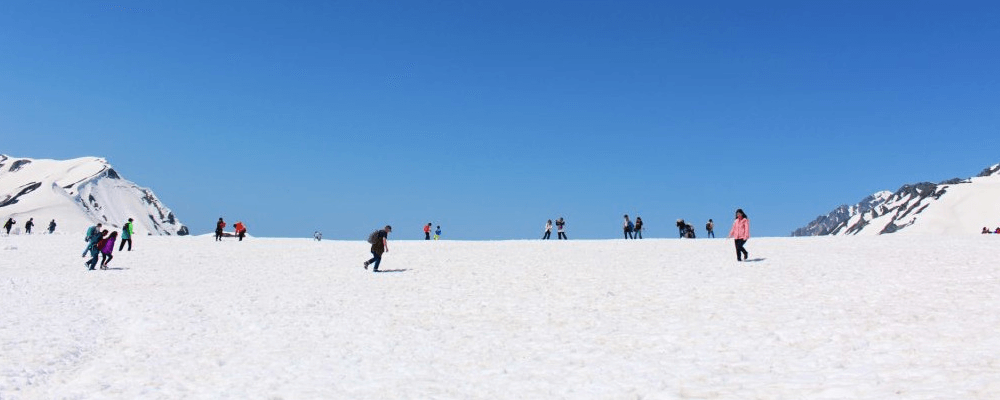
In doing so, the grand Snow Walls of Tateyama-Kurobe are carved anew. Towering up to 20 meters in height, the vast walls dwarf not only people but also the large coaches that transport them to and from Murodo Station. Although the Snow Walls are only one visible for a matter of months, they are without doubt the most famous attraction of the Tateyama-Kurobe Alpine Route – one of Japan’s most iconic sights.
1 Day Tour
| 1-Day Togakushi Legends Tour: Hands-on Soba Noodles, Ninja Village, and Hidden Shrines | |
|
| |
| Period | July to November |
| Time | 09:35 – 17:20 |
| Meeting Place | Nagano Station Information Board |
| Adult Rate | ¥19,800 |
| Child Rate | ¥11,000 |

Sitting quietly in the mountains bordering Nagano City, Togakushi is home to some of Japan’s most important Shinto shrines set among a beautiful forested landscape. The five major shrines that make-up the Togakushi complex are spaced-out at intervals through the forest and set against the dramatic background of mountains rising above. Accessible via well-maintained walking tracks, Togakushi continues to draw Shinto practitioners and nature enthusiasts who revel in its tranquility, beauty, and purity.
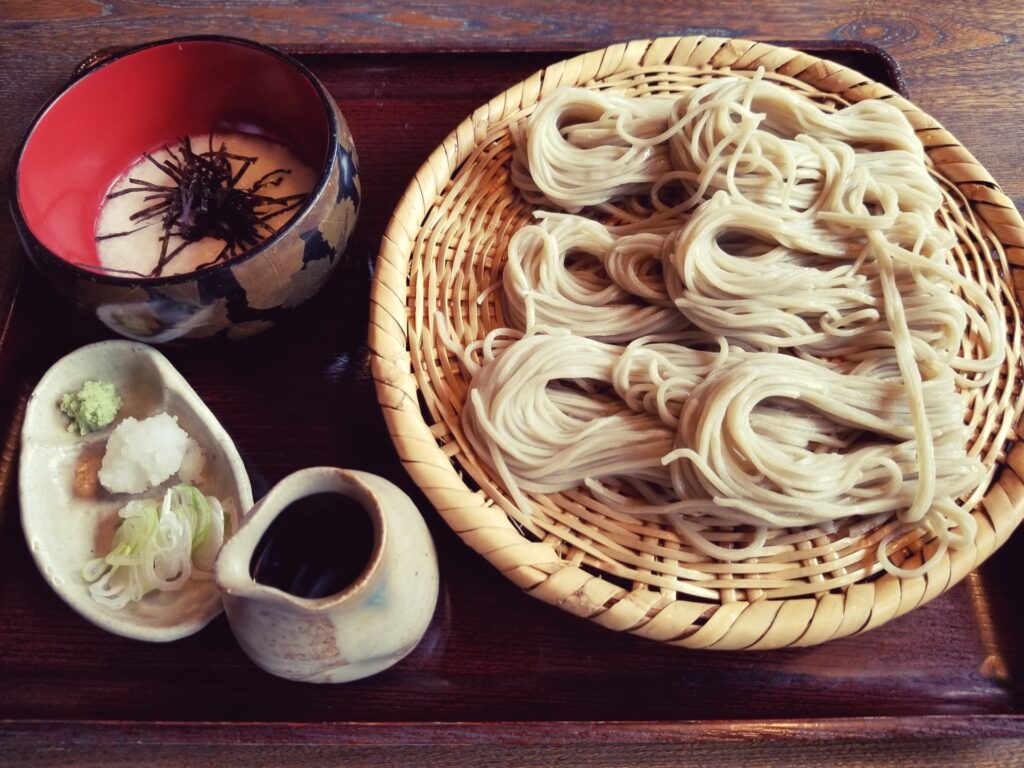
On the literal doorstep of the city, Togakushi is also home to the Togakure ninja school, Togakushi Ski Resort and famous for its ‘soba’ (buckwheat noodles), traditional bamboo craft and stunning autumn leaves making it an ideal destination when planning at day-trip from Nagano.
1 Day Tour
| 1-Day Tour from Nagano and Matsumoto: Kamikochi & Matsumoto Castle | |
|
| |
| Period | April to November |
| Time | 08:15 – 18:30 |
| Meeting Place | Nagano Station Matsumoto Station |
| Adult Rate | ¥23,800 |
| Child Rate | ¥11,900 |

Often described as one of the country’s most beautiful natural treasures, Kamikochi sits high in the Hida Mountains – Japan’s highest mountain range. Also known as the ‘Kita Alps/Mountains’ or ‘North Japan Alps, the mountain range is one of three – along with the Kiso and Akaishi Mountains (or Central and Southern Japan Alps) – which make-up Japan’s mountainous heartland.
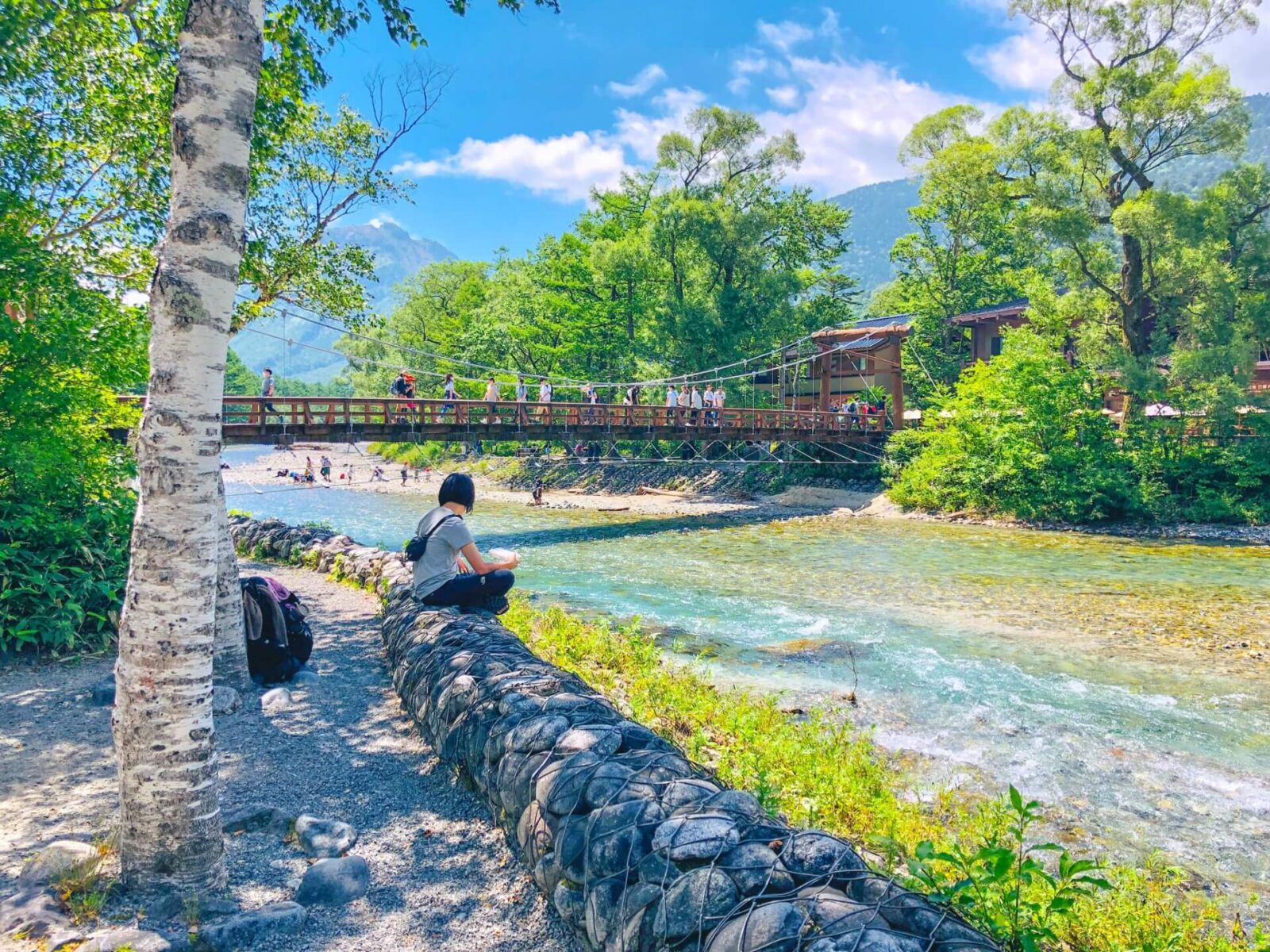
Nestled high in the Hida Mountains, Kamikochi is found at the southern tip of the Chubu Sangaku National Park. A true alpine oasis sitting beneath the high peaks of Mt Yari (3180m), Mt Hotaka (3190) and Mt Yakedake (2455m), the valley follows the Azusa River and is home to diverse range of flora and fauna. Hiking trails span-out along the valley floor and follow the river as it meanders north to south, before more advanced hiking and climbing routes ascend to the mountains above. It is truly one of Japan’s most remarkable natural landscapes.

We also offer charters to the Monkey Park (and other destinations around Central Japan) for travelers in need of transportation only.
25 THINGS TO DO AROUND THE PARK & WHERE TO STAY
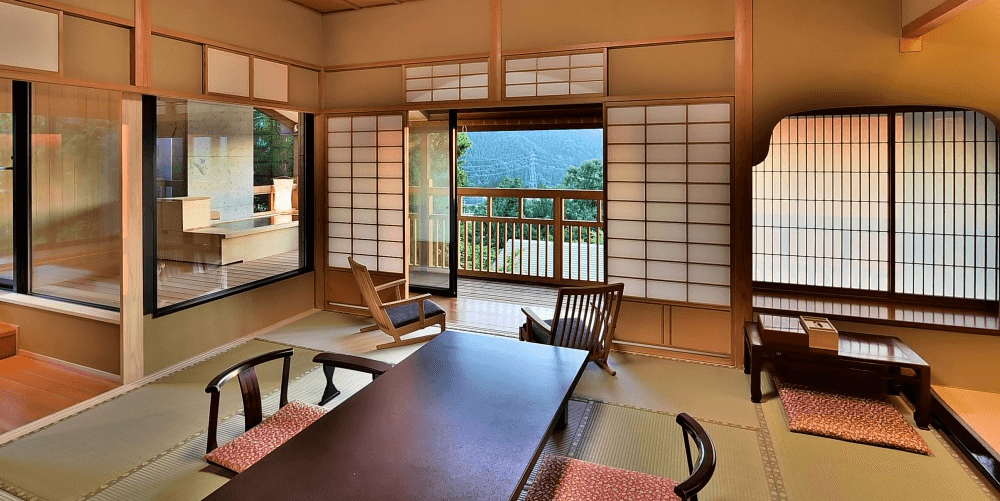
Often referred to as the Snow Monkey Park, you’d be forgiven for thinking the park is only open and the monkeys only venture there in winter. While it’s true they are most famous for their winter antics, the monkeys come to the park all year round and there are just as many reasons to visit in spring, summer and autumn. Located in the beautiful rural enclave of Yamanouchi and within easy reach of Nagano City, visiting the park can be easily combined with plenty of nearby destinations and activities, as a day-trip or multi-day visit. Our ’25 Things To Do Around The Jigokudani Monkey Park & Where To Stay’ page has lots of great tips and suggestions of what’s on offer throughout the year.


